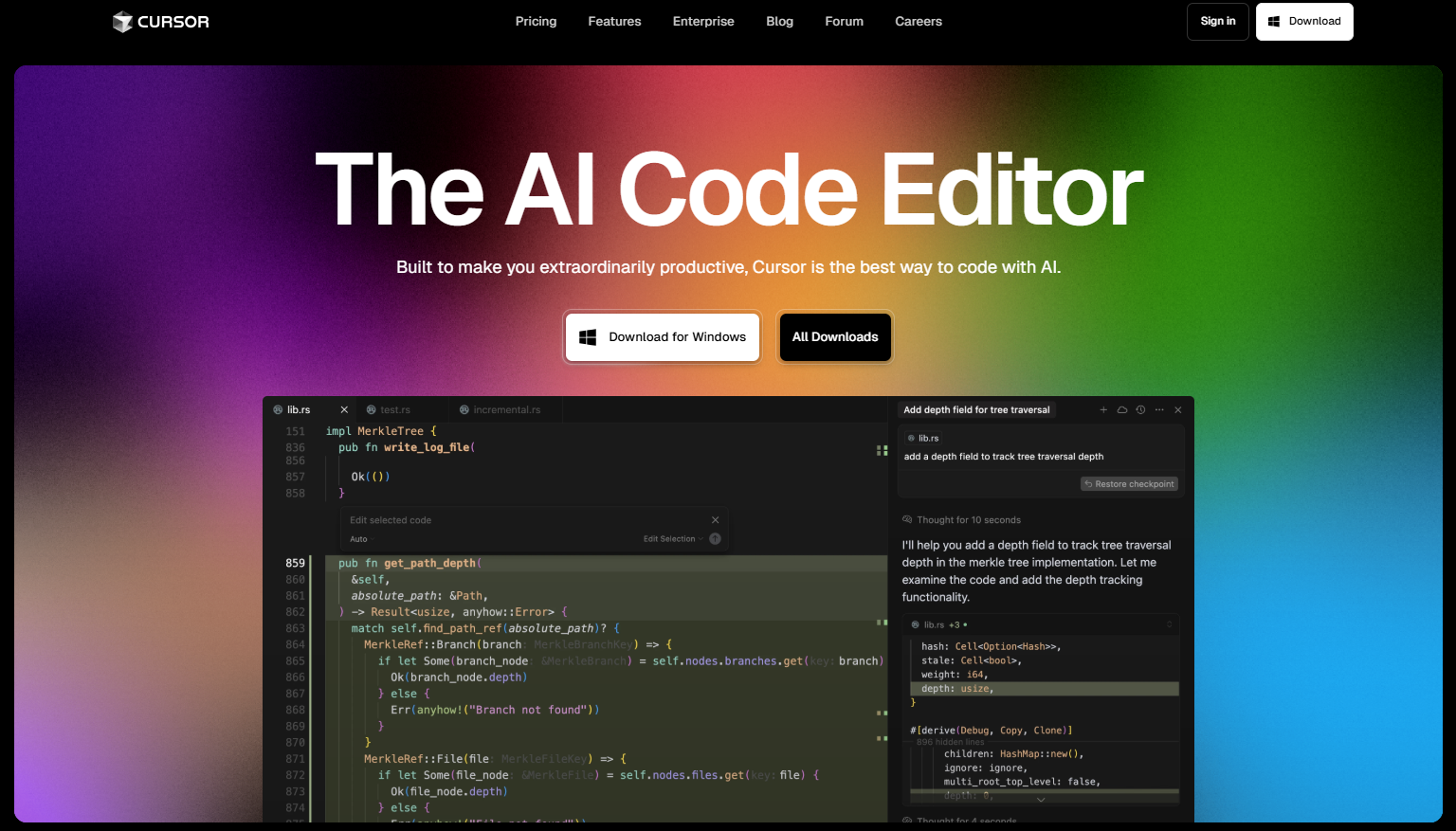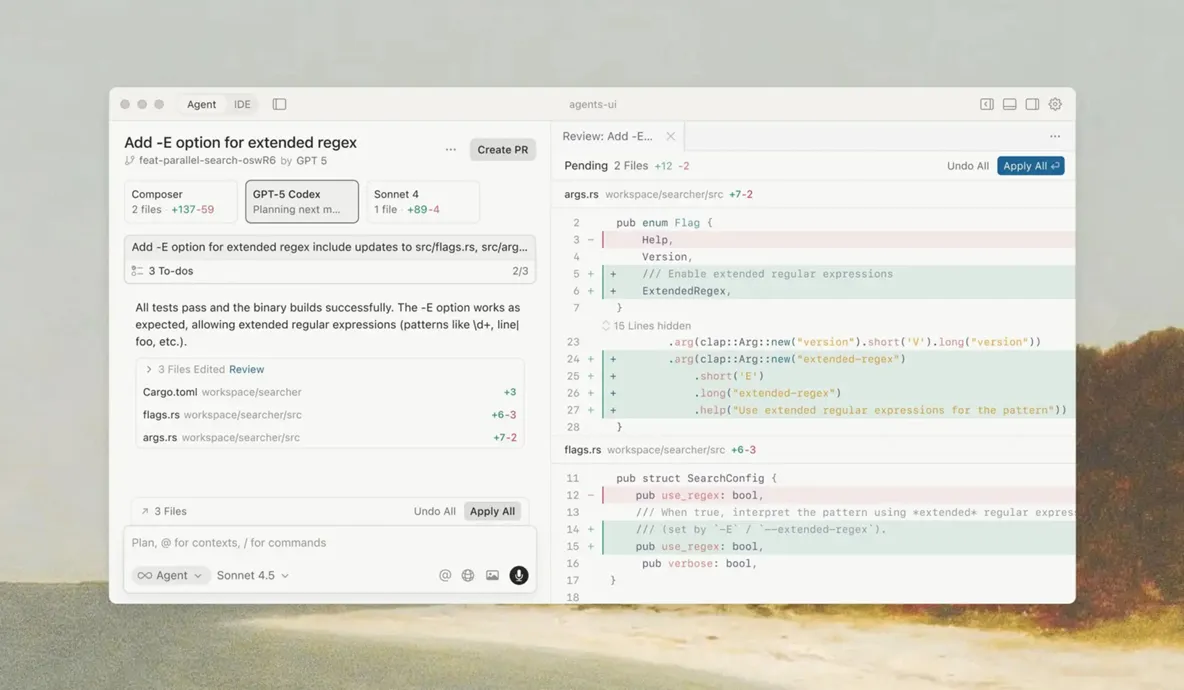
Review of Cursor 2.0: Revolution in AI-Assisted Programming
Hey friends! My name is John, and I've been working in software development for several years now. During this time, I've tried out a ton of tools—from classic IDEs like Visual Studio Code to experimental AI assistants like GitHub Copilot. But recently, Cursor 2.0 came out, and I couldn't pass it by. I installed it right after the release at the end of October 2025 and spent a whole week testing it on real projects: from simple Python scripts to complex web apps on React and Node.js. In this article, I'll tell you about Cursor 2.0 from a first-person perspective—detailed, with examples, pros, and cons. This isn't just a review; it's a full-fledged guide to help you decide if it's worth switching to this tool. Let's figure out why Cursor 2.0 is being called "the best AI code editor of 2025."
What is Cursor and Why is 2.0 a Breakthrough?
Cursor is an AI-oriented code editor built on the base of Visual Studio Code, but with deep integration of artificial intelligence. It emerged as an alternative to Copilot but quickly evolved into a full-fledged IDE where AI doesn't just suggest code but actively participates in development: plans tasks, edits files, tests, and even debugs. The first version of Cursor was already cool—with chat, auto-completion, and contextual project understanding. But Cursor 2.0 raises the bar to a new level, shifting from an "AI assistant" to a "multi-agent system."
The release happened around October 29, 2025, and it includes the new Composer model, a multi-agent interface, a built-in browser, and a bunch of optimizations. Essentially, Cursor 2.0 isn't an update; it's a rethinking of the workflow: from file focus to task and agent focus. I tried it on macOS (it's also supported on Windows and Linux), and installation took minutes: downloaded from cursor.com, logged in, connected keys from OpenAI/Anthropic (Composer works out of the box). Minimum requirements—8 GB RAM, but for large projects, I recommend 16+.
Unlike its predecessor, 2.0 emphasizes an "agent-centric" approach: you describe the goal, and AI agents (up to 8 in parallel) handle planning, coding, and testing. This is ideal for solo developers, teams, and even students learning coding.

Key New Features of Cursor 2.0
Let's break down what's new. I'm basing this on the official changelog and my own tests, plus community feedback (for example, on X, where users praise the UI).
Composer: The New Frontier Model for Code
Composer is Cursor's own model, tuned specifically for coding. It's 4 times faster than similar models (like GPT-5 or Sonnet 4.5), with inference up to 200 tokens per second. In my tests, it completed tasks in 10-30 seconds: for example, refactoring a Python function while considering the project's style. Composer uses a mixture-of-experts (MoE) architecture, optimized for long context and tools. It "solves" tasks decisively: immediately uses files, runs commands, follows the plan without extra words.
Example: I asked, "Rewrite this endpoint on Node.js, add validation with Zod and tests with Jest." Composer not only generated the code but also accounted for the existing style (async/await instead of promises), passed the linter, and ran tests in a sandbox. Downside: for super-complex tasks (like deep refactoring of a monolith), it's better to switch to GPT-5 Codex—Composer sometimes "invents" non-existent helpers.
Multi-Agent Interface: Up to 8 Agents in Parallel
This is the killer feature! In 2.0, you can run up to 8 agents simultaneously, each in an isolated git worktree (to avoid conflicts). Agents work in parallel: one plans, another codes, a third tests. In the UI—sidebar with agents and plans, chat in the center, browser on the right.
In my project (a web app on React/Next.js), I ran 3 agents: one for frontend (adding a form), second for backend (API), third for tests. They worked independently, without collisions, and I merged changes with one click. Patterns: "diversity" (multiple plans to choose from) or "separation" (dividing tasks). Cloud agents—99.9% uptime, instant start.
Feedback on X: Users like @kevinrose discuss how to avoid collisions—Cursor solves this with worktrees, but you need to clearly define the scope. I noticed: without control, agents can "rewrite" the same thing, wasting resources.

Built-in Browser and Voice Mode
The browser (now GA) allows agents to test UI inside the editor: screenshots, DOM inspection, clicks. Ideal for full-stack: an agent starts a local server, checks a bug, and fixes it. In a test on a React form, the agent "saw" a rendering error and fixed the CSS/JS.
Voice Mode—voice control: dictate a prompt, AI converts to text and runs it. I used it for "add test for aria-label"—convenient when pairing with a colleague, but worse in a noisy office.
Performance Improvements and Code Review
LSP (Language Server Protocol) is accelerated: for large projects (TypeScript/Python), loading is 2-3 times faster, fewer memory leaks. Code review: View all changes in one window, without jumping between files.
Plan Mode: Plan in the background (with one model), build with another. Team Commands: Admins set rules for the team (e.g., "always use Vitest").
Other Features
Sandboxed terminals: Safe commands (no internet by default) on macOS.
Improved prompt UI: Files as "pills," auto-context collection.
Enterprise: Audit logs, hooks, SAML.
Language support: Python, JS/TS, Go, Java, C#. Frameworks: React, Next.js, Prisma. Compatible with VS Code extensions.
How to Use Cursor 2.0: Practical Examples
Let's move to real scenarios. I tested on my pet project—a TODO app with backend on Express and frontend on React.
Bug Fix: Prompt: "Find and fix the bug in authentication, test in the browser." The agent used the browser, reproduced the error, generated a patch, and tests. Time: 20 sec.
Refactoring: "Switch to async/await throughout the project, add Zod types." Multi-agent: One for front, another for back. Merged diffs—all passed CI.
New Feature: "Add voice search with Speech-to-Text." Composer generated code, integrated with existing components.
Tips: Set clear goals, use house rules (style settings), review diffs. For multi-agent—limit scope to avoid deviations.
In the community on X, praise abounds: @rexan_wong says the UI looks "sophisticated," and @leerob shares how to build personal tools in 2 prompts.
Pros and Cons of Cursor 2.0
Pros:
Speed: 4x faster, saves hours on routine.
Flexibility: Switch between Composer, GPT-5, Claude.
Security: Sandbox, enterprise controls.
Improved Workflow: Less context-switching, better for teams.
Price: Free for testing, Pro $20/month (unlimited completions), Teams $40/user.
Cons:
Learning Curve: New UI can confuse (but you can switch to classic).
Not Always Perfect: Composer weaker on edge cases, parallel agents need oversight.
Network Dependency: Core AI is cloud-based.
Pricing: Usage-based, can be unpredictable for heavy users.
Comparison with Competitors
Vs VS Code + Copilot: Cursor is more integrated for agents, browser, and multi-file edits. Copilot is simpler and cheaper ($10/month), but without parallel.
Vs Replit or Claude Code: Cursor is faster and tool-heavy, but Claude is better for "pure" chat.
Comparison Table:
AspectCursor 2.0VS Code + CopilotGitHub CopilotAI IntegrationMulti-agent, browserInline + chatInline completionsSpeed4x fasterAverageGoodPrice$20+$10$10For TeamsYes, enterpriseLimitedYes
Recommendation: If you're on Copilot, try Cursor for complex tasks.
Conclusion: Is It Worth Switching?
Cursor 2.0 isn't just an editor; it's a coding partner. In my tests, it cut development time by 50-70%: from ideas to code in minutes. If you're a developer, startup founder, or learning—must-try. There are downsides, but the pros outweigh them. Download from cursor.com, test on the free plan. The future of coding is in agents, and Cursor is leading.
If you have questions—write in the comments. I'll keep monitoring updates and sharing. Good luck with coding!